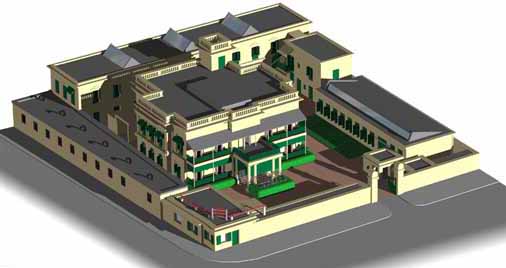
I should explain that Baptist Mission Press is one of the best known private printing presses in the country. It would be no exaggeration to say 'the Far East,' although there was an American Baptist Mission Press in Rangoon. This Press ceased to function when the Japanese Army invaded Burma. All the machinery was taken over, dismantled and shipped to Japan.
The Calcutta Press was established in 1818 and over the years a vast range of languages was built up: more than 40. And very many more if the total includes dialects and minor languages using the same script.
Some people have an impression that BMP, as it was best known, was a pioneer Press. This is not so. (1) It was a missionary enterprise that first brought printing into prominence in India. Probably the first book to be printed from moveable type was 'Conclusoes', produced in Goa, on the west coast of India. Roman Catholic names have been known since 1561, and one name that recurs is that of Ziegenbalg, one of two Germans who responded to an appeal by the King of Denmark for someone to go out and alleviate "appalling suffering" in India. Ziegenbalg became a famous Tamil scholar. A printing press was captured by the English at Pondicherry and another Tamil scholar, Fabricus, was placed in charge. He lived at Vepery, Madras. That press became the Diocesan Press, the oldest Mission Press in India, but with a broken history.
The purpose of BMP in Calcutta was primarily the production of Christian literature, which naturally took priority over commercial work. To the dismay of many evangelicals in British churches, BMP produced commercial work. All Christian literature is subsidised and the 300 men who worked at BMP, many of them highly skilled, could not be paid their wages out of Christian literature alone. Such British critics also lost sight of the fact that, mainly through the printing of University examination papers in the security press inside the press, £12,000 to £15,000 could be given to the BMS for redistribution to the India field, so that evangelists, teachers and nurses could be paid. There was nothing to apologise for. Those same critics seemed to consider it wrong for a Christian run Press to make a profit. In the 20 years I was at the Press I helped to raise more than £200,000 in hard cash - again, mainly from commercial work, in competition with other big presses in Calcutta.
Suresh Babu was entrusted with the entire organization of the Confidential Department. The fewer the number of people who knew the ins and outs of that department the better. When I read the final print-order proofs of examination papers, I had not the faintest idea which university they were intended for. I met the registrars when they came to the Press but all details as to which papers we would handle were left entirely to Suresh.
It was only when the bills went out that I saw the name of the university.
Suresh was responsible for the exact amount of paper used. Every sheet had to be accounted for, so there could be no question of a 'leak'. Every box that was packed was checked, wire-bound and lead sealed. The box-maker delivered wooden boxes by the handcart load. We were his chief customers.
It was a wonderful system. In all that Suresh did he was a model of integrity because he had been brought up in a Christian-run Press from the age of fourteen. Everyone trusted him, from the management to the most skilled men and right down to peons and coolies. I relied on his advice.
The Confidential Department was a self contained Press of which visitors were unaware. The entrance was a thick, wide, heavy wooden door. Nothing more than that. Through that door passed not only the manuscripts of thousands and thousands of university examination papers but the men whose work was to convert them into print, without blemish.
When proof-reading, if a scholarly question-setter had set a question that was too involved and ungrammatical I could consult our head proof-reader, Mr Laxminarayan, who was a barrister by profession. He was another man on whom we could rely implicitly. How the Press found men of such quality in the first place, I do not know.
The Confidential Department supplied universities all over India and was the most profitable part of the Press. I am aware of no occasion when there was any question over its integrity. The system worked perfectly.